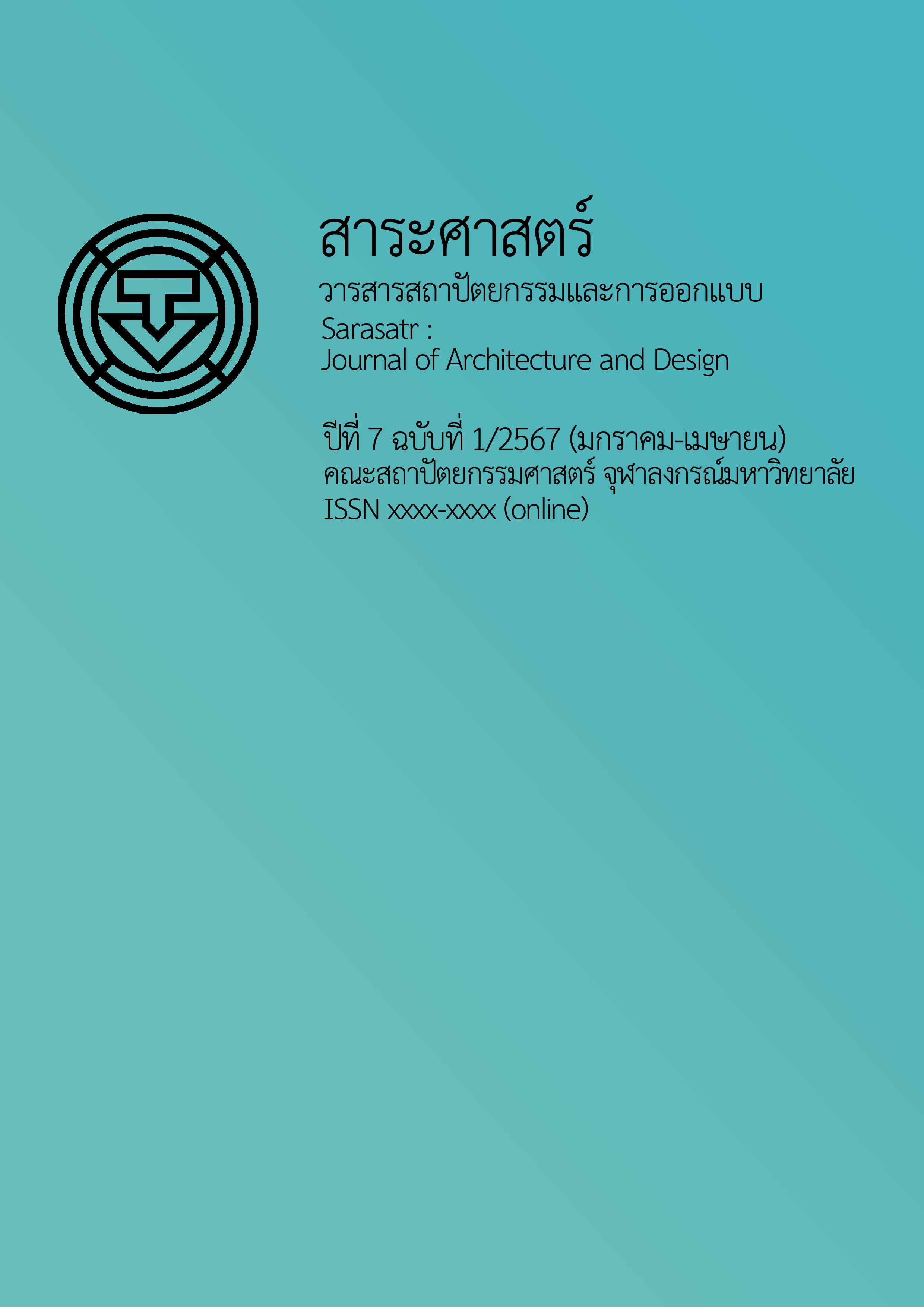The Roles and Changes of Kaeng Nam Ton Wetland, Mueang Khon Kaen District, Khon Kaen Province
Main Article Content
Abstract
The wetlands play an important role in ecosystems because they are the boundary between terrestrial and aquatic ecosystems. The distribution of wetland types and quantities varies by topography with specific vegetation characteristics of adapted to the constantly changing water environment and confined soil conditions. As a result, each wetland has the particularities that vary according to the dimensions of space and time. For this reason, the role of wetlands is important to creatures living around them. However, it has been found that the number of wetlands has decreased significantly due to changes in areas to accommodate urban expansion or from encroachment, and the occupancy of wetlands for agriculture, resulting in the deterioration of wetlands and leading to the permanent loss of wetlands.
The objective of this research is to study the role and changes of Kaeng Nam Ton wetlands, Khon Kaen Province within a time limit of changes in the role of wetlands caused by a development project for water retention for agricultural use by using satellite image data from 2001 to 2022 and a geographic information system classifying land use and analyzing changes in two periods, namely during 2001 to 2010 and during 2010 to 2022 as well as analyzing to explain how such changes affected the role of Keang Nam Ton wetlands.
The research results revealed changes. Rice fields and forest areas tended to decrease while urban areas and built-up structures tended to increase. Moreover, there were increasing areas of aquaculture facilities and other agricultural areas. It has also been found that after 2001, Keang Nam Ton wetland have changed in size with dwindling areas due to changes for water retention and the construction of a water storage dam for water use in agriculture. These changes have reduced the ecological role of areas and may result in the deterioration of wetlands, leading to the loss of wetlands.
Article Details
References
กรมทรัพยากรธรณี. (2528). แผนที่ธรณีวิทยาประเทศไทย จังหวัดขอนแก่น มาตราส่วน 1:250000. กระทรวงอุตสาหกรรม.
จิดาภา ช่วยพันธุ์, อนุสรา อนุวงค์, ธนพร ดวงเด่น, และสิรีธร จารุธัญลักษณ์. (2565). ย้อนรอยเส้นทางเศรษฐกิจ 3 ภูมิภาค...ไม่อ่าน ไม่รู้. Regional Letter, 2, 1/4-4/4.
ธีรวุฒิ ชิยานนท์. (2547). การกำหนดพื้นที่ศักยภาพเพื่อการฟื้นฟูพื้นที่ชุ่มน้ำ บริเวณลุ่มน้ำทะเลสาบสงขลา [วิทยานิพนธ์ปริญญามหาบัณฑิต, จุฬาลงกรณ์มหาวิทยาลัย]. ThaiLIS. http://thailisdb.car.chula.ac.th/CU_DC/Thesis/January2006/Theerawut.pdf
บัวพันธ์ พรหมพักผิง, ยรรยง อินทร์ม่วง, และมนต์ชัย ผ่องศิริ. (2562). เมืองขอนแก่น การเติบโต ความท้าทาย และโอกาส. สำนักพิมพ์สถาบันสิ่งแวดล้อมไทย-International Development Research Centre.
ประยูร วงศ์จันทรา, น้ำทิพย์ คำแร่, วุฒิศักดิ์ บุญแน่น, สุภารัตน์ อ่อนก้อน, กรรณิกา สุขงาม, อุไรวรรณ พรายมี, ปนัดดา ฤทธิ์สำแดง, สุรศักดิ์ แก้วงาม, และธงชัย พรยุศรี. (2564). หลักสูตรการเรียนรู้พื้นที่ชุ่มน้ำภาคตะวันออกเฉียงเหนือ : อ่างเก็บน้ำหนองบัว อำเภอกันทรวิชัย จังหวัดมหาสารคาม. สำนักพิมพ์แรบบิท4พริ้นต์.
ภาคภูมิ สุขีสนธิ์ และภาณุพันธุ์ ประภาติกุล. (2560). การมีส่วนร่วมของเกษตรกรในการอนุรักษ์ทรัพยากรน้ำเพื่อการเกษตร ศึกษากรณี บึงแก่งน้ำต้อน อำเภอเมืองขอนแก่น จังหวัดขอนแก่น. แก่นเกษตร, 45(3), 475-478.
มงคล ไชยภักดี และวัลยา ชนิตตาวงศ์. (2550). สถานการณ์และการบริหารจัดการพื้นที่ชุ่มน้ำในประเทศไทย. Wildlife Yearbook, 8, 305-327.
เริงชัย ตันสกุล, เสาวภา อังสุภานิช, พิมพรรณ ตันสกุล, สมหมาย เชี่ยววารีสัจจะ, ฤดี รักษ์วงศ์, มานพ ประทุมทอง, ศุภิชัย ตั้งใจตรง, สุระ พัฒนเกียรติ, สุธีระทองขาว, และโสพล สวัสดิ์รักษา. (2538). รายงานการศึกษาการฟื้นฟูทะเลสาบสงขลาตอนกลาง. มหาวิทยาลัยสงขลานครินทร์.
วุฒิชาติ สิริช่วยชู. (2552). กลุ่มชุดดิน เอกสารวิชาการฉบับที่ 1. กรมพัฒนาที่ดิน กระทรวงเกษตรและสหกรณ์.
สันติ ภัยหลบลี้. (2562, 15 มีนาคม). 6 ขอนแก่น : ภูมิศาสตร์.แผนที่. มิตรเอิร์ธ. https://www.mitrearth.org/m6-khon-kaen/
สถิระ อุดมศรี และจตุรงค์ ละออพันธ์สกุล. (2556, 9 กันยายน). ความสัมพันธ์ระหว่างชุดดินกับสภาพพื้นที่ธรณีวิทยาบริเวณภาคตะวันออกเฉียงเหนือ [เอกสารนำเสนอในที่ประชุม]. การประชุมการเผยแพร่องค์ความรู้ด้านทรัพยากรดิน ภาคตะวันออกเฉียงเหนือ. สำนักวิทยาศาสตร์เพื่อการพัฒนาที่ดิน, กรุงเทพมหานคร.
สุนันทา สุกโกศล และอัจฉราภรณ์ ภักดี. (2555). ความสำคัญของพื้นที่ชุ่มน้ำกับสภาพเศรษฐกิจ [เอกสารนำเสนอในที่ประชุม]. The 13th Graduate Research Conference Khon Kaen University. มหาวิทยาลัยขอนแก่น,ขอนแก่น.
สุวรรณา รองวิริยะพานิช, จรัณธร บุญญานุภาพ, ดลเดช ตั้งตระการพงษ์, ปราณี นางงาม, กัมปนาท ปิยะธำรงชัย, ศศิมา เจริญกิจ, และปีย์ชนิตว์ เกษสุวรรณ.(2564). แนวทางการปฏิบัติที่ดีในการฟื้นฟูและบริหารจัดการพื้นที่ชุ่มน้ำในเมืองของภาคเหนือ. สำนักพิมพ์เอเชีย ดิจิตอล การพิมพ์.
Bedford, B. L., Leopold, D. J., & Gibbs, J. P. (2001). Wetland ecosystems. Encyclopedia of Biodiversity, 7, 384-402.
Etherington, J. R. (1983). Wetland ecology. Edward Arnold.
Finlayson, C. M., Bellio, M. G., & Lowry, J. B. (2005). A conceptual basis for the wise use of wetlands in northern Australia-linking information needs, integrated analyses, drivers of change and human well-being. Marine and Freshwater Research, 56(3), 269-277.
Gibbs, J. P. (2000). Wetland loss and biodiversity conversation. Conversation Biology, 14(1), 314-317.
Ji, W., Xu, Z., & Murambadora, D. (2015). Understanding urban wetland dynamics: Cross-scale detection and analysis of remote sensing. International Journal of Remote Sensing, 36(7), 1763-1788.
NextGis. (n.d.). From ESRI world topo. https://qms.nextgis.com/geoservices/519/


